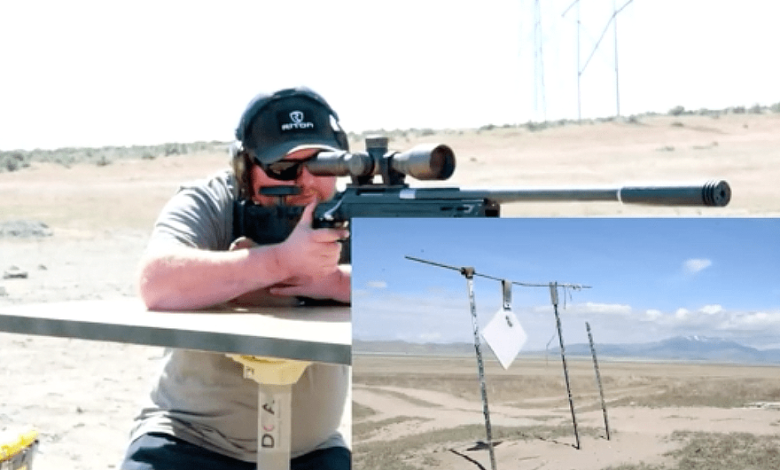Ballistics for Dummies: A Beginner’s Guide to Bullet Flight

When a shooter pulls the trigger, a series of events sets the bullet on its path toward the target. While shooting may seem straightforward, the science behind how a bullet travels is far more complex.
Understanding the basics of ballistics can significantly improve a shooter’s accuracy and performance. But what exactly happens between the muzzle and the target? In this article, we’ll break down the fundamentals of ballistics in simple terms, helping beginners grasp how a bullet behaves in flight and how external factors like gravity, air resistance and wind can impact its trajectory.
Whether you’re new to shooting or simply looking to refine your knowledge, this article will provide insights into the key elements every shooter should know about bullet flight.
Key Takeaways
Ballistics is essential for accurate long-range shooting, but it doesn’t require being an expert. The key to success is understanding and controlling variables such as ammunition, rifle setup and atmospheric conditions. Even beginners can greatly improve their accuracy by using ballistic calculators and inputting precise data like muzzle velocity, bullet weight and atmospheric factors.
Consistency in ammo and attention to detail are crucial. While ballistic software simplifies calculations, real-world practice and understanding variables like wind and temperature are just as important.
What is Ballistics?
Ballistics is the science of how projectiles move through space. In the context of firearms, it refers specifically to how bullets behave once they leave the barrel. Understanding ballistics helps shooters predict and control where their shots will land. Broadly, ballistics can be broken down into three categories:
- Internal Ballistics refers to what happens inside the firearm, from the moment the primer ignites the powder until the bullet exits the barrel. It involves factors like barrel length, barrel twist rate and the bullet’s muzzle velocity.
- External Ballistics – External ballistics take over once the bullet leaves the barrel. This part of ballistics deals with how the bullet travels through the air, encountering forces like gravity, air resistance and wind that impact its path.
- Terminal Ballistics – This final stage is when the bullet impacts its target. It encompasses how the bullet penetrates the target, its speed at impact, and the damage it can cause.
While these categories may seem technical, understanding them is crucial for improving shooting accuracy. Each stage is influenced by variables that a shooter can learn to control or account for during their shot.
Internal Ballistics – What Happens Inside the Barrel
Internal ballistics focuses on the bullet’s journey from the chamber to the end of the barrel, and understanding this process is key to improving accuracy and firearm performance. Here’s a breakdown of the key components involved:
- Ignition of the Primer and Powder: When you pull the trigger, the firing pin strikes the primer, igniting the gunpowder inside the cartridge. This explosion creates high-pressure gas, which propels the bullet forward down the barrel.
- Bullet Movement in the Barrel: As the gas expands, it pushes the bullet forward. The rifling inside the barrel, which consists of spiral grooves, forces the bullet to spin. This spin stabilizes the bullet, making it more accurate as it travels toward the target.
- Muzzle Velocity: The speed of the bullet as it exits the barrel is called muzzle velocity. A higher muzzle velocity generally means a flatter trajectory, but it’s affected by several factors like barrel length and the type of ammunition used. Shorter barrels often produce lower muzzle velocity because the bullet has less time to accelerate before leaving the barrel.
Internal ballistics is important because it directly influences the bullet’s speed and stability as it exits the firearm. If the bullet doesn’t leave the barrel with the right amount of spin and speed, it won’t fly straight, no matter how well you aim.
External Ballistics – How Bullets Travel Through the Air
Once the bullet exits the barrel, external ballistics takes over. In this phase, a shooter’s understanding of environmental factors becomes critical, as various forces influence the bullet’s path to the target. Here’s what every shooter should know about external ballistics:
- Gravity: As soon as a bullet leaves the barrel, gravity pulls it downward. This is why a bullet doesn’t travel in a perfectly straight line but rather follows a curved path called a trajectory. Shooters must account for gravity, especially at longer distances, by adjusting their aim higher than the target.
- Air Resistance (Drag): As the bullet moves through the air, it encounters resistance, which slows it down. The shape of the bullet, its speed and even the air density (which can vary depending on altitude and weather) all affect how much drag the bullet experiences. Higher speeds tend to reduce the impact of drag initially, but the bullet will decelerate over longer distances.
- Wind: Wind is one of the most unpredictable factors in external ballistics. Depending on its direction and strength, it can push the bullet off course, either to the left or right. Shooters need to adjust their aim to compensate for wind drift, especially in long-range shooting, where wind can have a more significant impact on bullet flight.
- Spin Drift and the Coriolis Effect: While less of a factor in short-range shooting, spin drift and the Coriolis effect come into play over long distances. Spin drift occurs because the bullet’s rotation causes it to drift slightly to the side (usually to the right if the rifling twists that way). On the other hand, the Coriolis effect is the Earth’s rotation affecting the bullet’s path—again, a small factor unless shooting over extreme distances.
By understanding these external factors, shooters can adjust their aim and improve accuracy, even under changing environmental conditions. This knowledge is especially valuable for hunters and long-distance shooters who often contend with wind, drag and gravity over greater ranges.
Terminal Ballistics – What Happens When the Bullet Hits the Target
Terminal ballistics refers to a bullet’s behavior when it impacts its target, which is critical in hunting and personal defense. When a bullet strikes, its penetration depends on factors like velocity, mass and construction. For example, hollow point bullets are designed to expand upon impact, creating a larger wound channel while reducing the risk of over-penetration, which is ideal in self-defense. However, full metal jacket (FMJ) bullets penetrate deeper without expanding, which may be preferred in specific situations.
Energy transfer plays a key role in determining a bullet’s effectiveness on live targets. A high-velocity bullet with significant mass transfers more kinetic energy, leading to greater damage. This energy transfer can be the deciding factor in stopping a threat or ensuring a humane kill when hunting. As the bullet deforms or expands upon impact, such as with hollow points, it creates a wider wound channel and maximizes stopping power by dumping more energy into the target.
Upon impact, the bullet creates a temporary vacuum, or cavitation, that stresses surrounding tissues, causing additional trauma. The permanent wound channel left by the bullet reflects the path of destruction, damaging critical organs and blood vessels. The combination of energy displacement, bullet deformation and the resulting wound channel makes terminal ballistics a crucial consideration for hunters and those who use firearms for personal and home defense.
When Buying Ammo, What Ballistics Info Should I Pay Attention To?
When buying ammunition, understanding certain ballistic details can help you make the best choice for your specific needs, whether it’s for hunting, self-defense, target shooting or competition. Key information to look for includes:
Bullet Weight (Grains): This measures how heavy the bullet is. Heavier bullets, like 150-190 grains for a .308, offer deeper penetration and harder hits but have a more arched trajectory. Lighter bullets, such as 55 grains for .223, have a flatter trajectory but may not penetrate as deeply. Lighter bullets are better if you need fast, long-range accuracy; for closer ranges or larger targets, go for heavier bullets.
Muzzle Velocity: Muzzle velocity, usually measured in feet per second (fps), tells you how fast the bullet exits the barrel. Higher muzzle velocity gives a flatter trajectory, making it easier to hit distant targets, though the bullet decelerates faster. Look for higher velocities for long-range and flatter shots or lower velocity for controlled shots at shorter distances.
Muzzle Energy: This measures the bullet’s energy in foot-pounds (ft-lbs) as it exits the barrel. Higher muzzle energy translates to more impact force on the target, vital for hunting or self-defense. Look for ammo with higher muzzle energy if you’re after more stopping power. Lower muzzle energy might be sufficient for casual target shooting.
Ballistic Coefficient (BC) refers to a bullet’s ability to resist air drag, affecting how well it maintains speed and energy as it flies toward the target. A higher BC means the bullet flies faster, drops less, drifts less in the wind and delivers more energy upon impact. BC is influenced by the bullet’s weight, diameter and shape—the heavier, narrower and sleeker the bullet, the higher its BC. Bullets with high BCs look long, slim and pointy, with tapered boat tails designed for aerodynamic efficiency.
The ballistic coefficient becomes more important as the distance increases. Within 100 yards, it’s not a big concern—factors like accuracy and terminal performance (how the bullet behaves when it hits the target) matter more. However, at 200 yards and beyond, BC starts to have a noticeable effect. By 300 yards, a higher BC can make a significant difference in trajectory and energy retention, making it crucial for long-range shooting. When selecting ammo for longer distances, you must balance accuracy, terminal performance and a bullet’s aerodynamic shape for maximum effectiveness.
Understanding Ballistics for Better Shooting
Ballistics is a science that every shooter should understand to improve accuracy and make informed decisions about ammunition, firearms and shooting techniques. From the moment the bullet is fired until it hits the target, various factors come into play—internal ballistics govern what happens inside the barrel, external ballistics determine how the bullet travels through the air and terminal ballistics describes the bullet’s behavior upon impact.
Mastering the basics of ballistics can help shooters of all levels enhance their accuracy and effectiveness, whether in competition, hunting or self-defense. By accounting for factors like gravity, wind, bullet velocity and energy transfer, you can make smarter decisions in your shooting, ultimately improving your results.
Remember, no two shots are the same, and by understanding how each element of ballistics works, you can fine-tune your skills and consistently hit your target with confidence. Whether you’re new to shooting or looking to improve your skills, gaining a grasp on ballistics will give you a solid foundation for success.







